Hooke R.L. Principles of glacier mechanics
Подождите немного. Документ загружается.


Simple and pure shear 351
A useful measure of the magnitude of the total strain experienced by the
ellipsoid is then:
γ
oc
=
2
3
[
(
ε
1
− ε
2
)
2
+
(
ε
2
− ε
3
)
2
+
(
ε
3
− ε
1
)
2
]
1/2
(13.4)
γ
o
is called the natural octahedral unit shear (Nadai, 1950,p.115) and the
additional subscript c denotes cumulative. (“Natural” in this context is a
reference to the appearance of the natural logarithm in the expressions for
ε
i
, not to a contrast with some “artificial” counterpart.) The expression
on the right-hand side of Equation (13.4)istwice the root mean square of
the strains in the three mutually perpendicular planes of our coordinate
system.
In plane strain with ε
2
= 0 and ε
1
=−ε
3
, the intermediate or
Y-axis of the ellipsoid will be transverse to the flow and thus parallel
to the y-axis of the fixed coordinate system. Equation (13.4) can then be
simplified and combined with Equation (13.2)toyield:
γ
oc
=
2
√
6
3
ε
1
=
2
√
6
3
ln
1
o
(13.5)
or using Equation (13.2)toeliminate
o
:
γ
oc
=
√
6
3
ln
1
3
(13.6)
Simple and pure shear
As we have discussed previously (Figure 4.14), when a two-dimensional
object is deformed by a compressive stress parallel to the z-axis and
an extensional stress parallel to the x-axis, the deformation is known as
pure shear (Figure 13.3a), whereas if it is deformed by a shear stress,
σ
zx
, parallel to the x-axis, the deformation is known as simple shear
(Figure 13.3b). In Figure 13.3a the axis of maximum shortening is clearly
parallel to the z-axis and the axis of maximum extension is parallel to
the x-axis. This is also true of the instantaneous stretching axes,oraxes
along which the maximum and minimum normal strain rates occur dur-
ing any infinitesimal strain. Material lines (lines of physical points in the
deforming material) that are initially parallel to the instantaneous stretch-
ing axes remain parallel to these axes. The strain is thus irrotational, and
the deformation is said to accumulate coaxially.
In contrast, in simple shear the instantaneous stretching axes are
always at ±45
◦
to the direction of shear (θ
in
= 45
◦
,where the subscript
“in” refers to instantaneous or infinitesimal; see Figure 13.3b). How-
ever, the axis of maximum extension will be at 45
o
only after the first
infinitesimal increment of strain. In the next increment, the initial axis
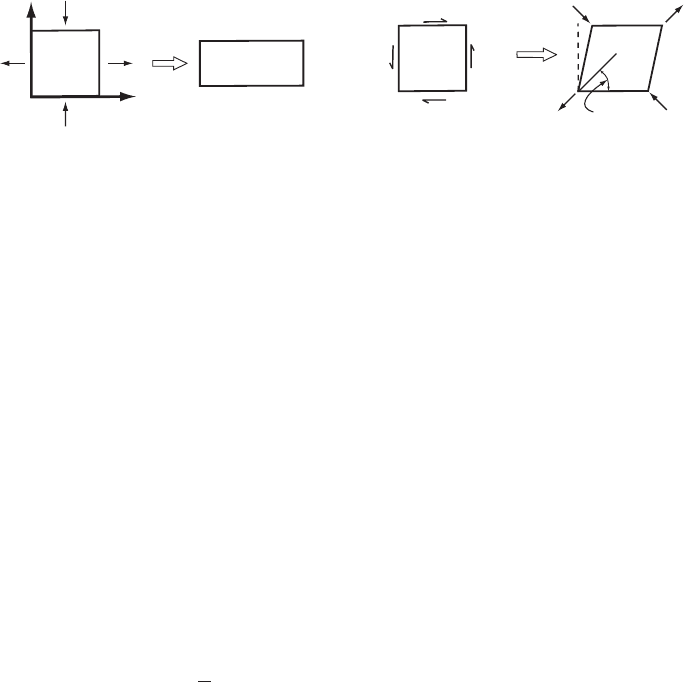
352 Finite strain and the origin of foliation
(b)(a)
s
zx
q
in
=
45
o
Simple shear
s
xz
Pure shear
z
x
Figure 13.3. Sketches illustrating (a) pure and (b) simple shear.
of maximum extension will be rotated slightly. This axis is parallel to a
material line that started at an angle greater than 45
◦
to the x-axis and
that has been rotated through the 45
◦
position to an angle less than 45
◦
.
This is most easily visualized if one considers very large strains, as in the
lower right part of Figure 13.1. The material line that became the nearly
horizontal axis of maximum extension in this case started off nearly
vertical. Because material lines rotate through the axes of instantaneous
stretching (which are non-material lines) the deformation in simple shear
is rotational and non-coaxial.
In either simple or pure shear there are always two lines that are
initially perpendicular and that are still perpendicular after deforma-
tion. These lines coincide with the directions of maximum extension (or
elongation) and shortening in the deformed state. They are called the
principal axes of strain.
Parameters describing cumulative deformation
Although γ
oc
describes the deformation of the original sphere, it does
not describe either its rotation or its final orientation. For that we need
two additional parameters, θ and ϕ (Figure 13.2); ϕ
c
is the angle through
which the material line that becomes a principal axis in the strained state
has rotated, and θ
c
is the angle that the greatest principal axis makes
with the x-axis.Again, the subscript c denotes cumulative.
In the pure shear of Figure 13.3a, the axis of maximum elongation,
the X-axis of the ellipsoid, is horizontal, both for infinitesimal strains
and for cumulative strain over a long period of time. Thus, θ
c
is 0, and
because the X-axis does not rotate, ϕ
c
is also 0. In contrast, in simple
shear as in Figure 13.3b, the X-axis is at 45
◦
to the shear direction for any
infinitesimal increment of strain. However, during any such increment,
the line that became the X-axis will have rotated slightly from its original
orientation, so ϕ
c
is slightly greater than 0 and θ
c
slightly less than 45
◦
.
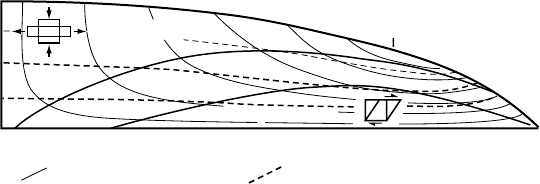
Calculating cumulative strain 353
Equilibrium
line
Mixed
Simple shear
Pure shear
Particle path
Isotime line (parallel to stratification)
Divide
Figure 13.4. Schematic illustration of the strain fields in an ice sheet. The fields
are for small increments of strain only. The horizontal component of the pure
shear field is extensional above the equilibrium line and compressive below.
(From Hooke and Hudleston, 1978, Figure 3A. Reproduced with permission of
the International Glaciological Society.)
As the strain accumulates, ϕ
c
will increase toward 90
◦
(but it will never
actually become 90
◦
) and θ
c
will approach 0
◦
. The reader may wonder
why ϕ
c
→ 90
◦
when the X-axis after the first increment of strain was
inclined at 45
◦
. The answer lies in the phrase “...the rotation of the
line that becomes the principal axis . . .”. After very large shear strains,
the line that becomes the X-axis will be the one that started out nearly
vertical.
As one would expect from consideration of velocity profiles like
those in Figure 10.6, pure shear dominates near the glacier surface where
∂u/∂x and ∂w/∂z are large compared with ∂u/∂z, and conversely, simple
shear dominates near the bed where ∂u/∂z becomes large compared
with ∂u/∂x and ∂w/∂z (Figure 13.4). Immediately beneath the divide,
∂u/∂z = 0atall depths, so the pure shear field extends all the way
to the bed. Near the equilibrium line, the vertical velocity decreases
and the flow gradually changes from extending to compressive so both
∂w/∂z and ∂u/∂x decrease. Thus the ratio of simple shear to pure shear
increases, so despite the small ∂u/∂z in the upper part of the glacier the
thickness of the pure shear field decreases.
Calculating cumulative strain
In order to calculate the cumulative strain in a glacier, one first must
know the velocity field. One then calculates the path that a particle of
ice would follow through the glacier and velocity derivatives at discrete
points along the path. To obtain the incremental strain as the ice moves
from one point to the next, strain rates are then calculated from the
velocity derivatives and multiplied by the time needed for this movement
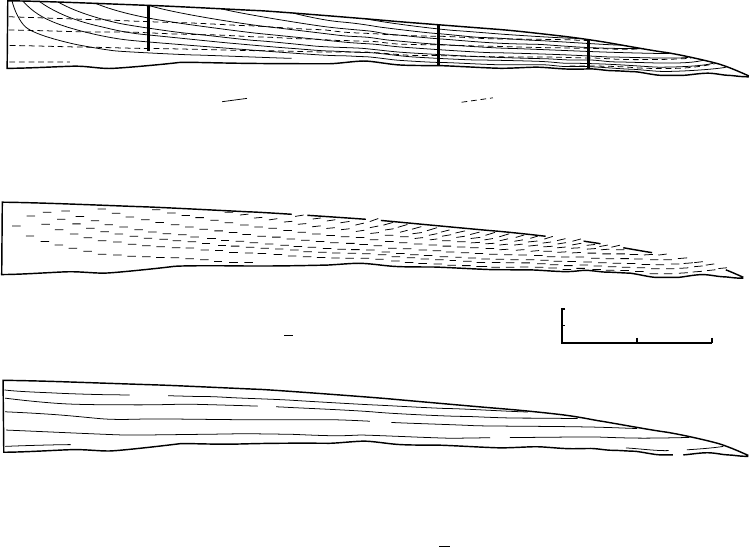
354 Finite strain and the origin of foliation
500
1000
2000
4000
a
1000
2000
4000
Particle path Isochron
T020
T061
T081
Divide
and isochrons
(a)
Particle paths
(b)
Direction of maximum cumulative extension
(c)
Cumulative strain magnitude,
g
oc
0.5
1
2
4
8
8
01 2km
0
200
m
Figure 13.5. (a) Particle paths calculated from the velocity field described in
the text. Ages of isochrons are shown in years. (b) Orientation of maximum
cumulative extension direction shown by bars at 200 m intervals along the
particle paths in (a). (c) Contours of
γ
oc
. (From Hudleston and Hooke, 1980,
Figures 6 and 7. Reproduced with permission of Elsevier Scientific Publishing.)
(Ramsay and Graham, 1970, Equations 7–10). Finally, these incremental
strains are added to get the cumulative strain.
Hudleston (Hooke and Hudleston, 1980; Hudleston and Hooke,
1980) made such a calculation using a comprehensive set of data on
velocities and mass balance along the flow line on Barnes Ice Cap illus-
trated in Figure 13.5a (see also Figure 12.17). To estimate horizontal
velocities at depth, he used measured surface velocities and adjusted
the value of B in Equation (5.7)toget zero velocity on the bed, where
the temperature is well below the melting point. Rather than use mea-
sured vertical velocities, he used the mass balance data to estimate the
long-term steady-state vertical velocity at the surface and assumed that
it decreased linearly with depth. Transverse strain rates are small, so he
assumed that they could be neglected.
The results of his calculations are shown in Figures 13.5 and 13.6.
By following particles starting at nine points in the accumulation area,
he first mapped nine flowlines (Figure 13.5a). He then calculated the
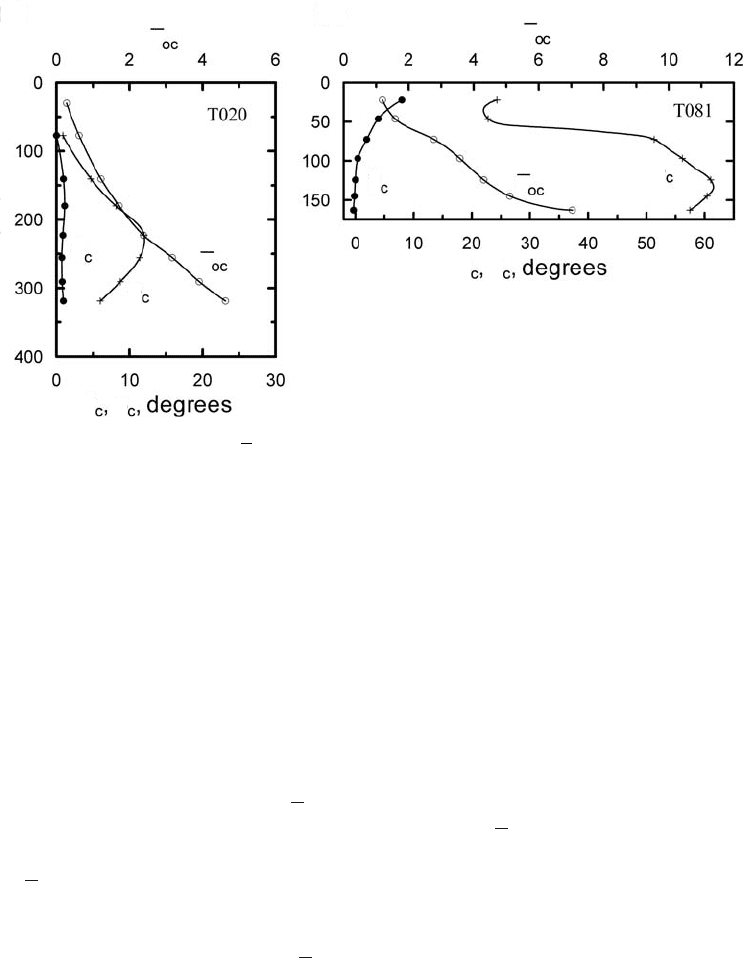
Calculating cumulative strain 355
(a)
(b)
g
g
g
q
j
q
j
q
j
q
g
j
Depth, m
Figure 13.6. Calculated variation of γ
oc
,yiθ
c
, and ϕ
c
with depth at locations of
Barnes Ice Cap boreholes (a) T020 and (b) T081. Locations of boreholes are
shown in Figure 13.5. (From Hooke and Hudleston, 1980, Figures 8a and 9a.
Reproduced with permission of the International Glaciological Society.)
orientations of the axes of maximum cumulative extension (X-axes:
Figure 13.5b). Noteworthy in this figure is the fact that these axes are
nearly parallel to the bed throughout most of the glacier. The increased
upglacier dip at the surface near and downglacier from borehole T061 is
a consequence of the increase in the ratio of simple shear to pure shear
as the equilibrium line is approached. As just noted, in simple shear the
axis of maximum elongation dips 45
◦
initially; with increasing defor-
mation it is gradually rotated toward parallelism with the plane of the
shear.
The cumulative strain magnitude,
γ
oc
,isshown in Figure 13.5c.
These numbers do not appear significant until one realizes that
γ
oc
is
proportional to the natural logarithm of the axial ratio of the strain ellipse.
Thus,
γ
oc
= 8, found in the most basal ice, corresponds to an elongation
of ∼18 000:1.A1mcube would be stretched into a 1-m wide ribbon
134 m long and 7.5 mm thick!
Figure 13.6 shows the variation of
γ
oc
, θ
c
, and ϕ
c
with depth in
boreholes T020 and T081 (Figure 13.5a). Because the dominant strain
pattern at T020, particularly in the upper part of the glacier, is nearly pure
shear with vertical compression and longitudinal extension, the axis of
maximum cumulative extension is nearly horizontal. Thus, θ
c
remains
close to 0. On the other hand, ϕ
c
is 0 at the surface and initially increases

356 Finite strain and the origin of foliation
gradually with depth as ∂u/∂z increases. However, with increasing depth
in the glacier, the ice arriving at T020 has passed through a larger and
larger region dominated by pure shear (Figure 13.4). Thus, ϕ
c
reaches
a maximum (∼12
◦
)atadepth of ∼240 m and then decreases at greater
depth.
The pattern at the site of borehole T081 is different in several
respects. Because this hole is in the upper part of the ablation area, ice
at the surface accumulated some strain as it moved from higher in the
glacier. Thus,
γ
oc
> 0atthe surface. With increasing depth, the ice has
traveled a greater distance and accumulated more strain so
γ
oc
increases
to about 7, representing an axial ratio of over 5000. Because ice near
the surface has experienced a modest amount of mixed simple and pure
shear (Figure 13.4), θ
c
≈ 10
◦
and ϕ
c
≈ 25
◦
here. With increasing depth,
ϕ
c
first increases, reaching a maximum at a depth of ∼120 m and then
decreases, reflecting the early history of pure shear that this deeper ice
experienced.
To further quantify the influence of the early history of pure shear,
Hudleston calculated ϕ
c
for a particle of ice that experienced a total strain,
γ
oc
,of3.75 entirely by simple shear (Hooke and Hudleston, 1980). In
this case, ϕ
c
is 80
◦
and increases toward 90
◦
as γ
oc
increases further. For
comparison, in holes T020 and T081 the actual rotations at this strain
magnitude are 9
◦
and 57
◦
, respectively.
Let us now use our understanding of cumulative strain to study the
origin of foliation.
Components of foliation
The pronounced banded character of glaciers (see, for example, Figures
5.18 and 8.8) has led to considerable confusion. Banding is most promi-
nent in the ablation area once the winter snow has melted. However, band-
ing may also be seen in crevasse walls in the accumulation area, although
it has a very different appearance there and most people would, correctly,
refer to it as annual layering or sedimentary stratification. The banding
is normally subparallel to the nearest bounding surface, be it the bed, the
surface, or the valley walls. However, in the lower part of the ablation area
it typically dips gently to steeply upglacier (Figure 13.7b). The banding
is penetrative; that is, the bands are cross sections of layers in the ice.
On close inspection, one finds that the banded appearance most com-
monly results from variations in bubble or dirt content. The latter, cou-
pled with the suggestive upglacier dip of the bands near the margin, has
given rise to the mistaken impression that the banding is a reflection of
shear planes in the ice along which debris was (somehow) carried to the
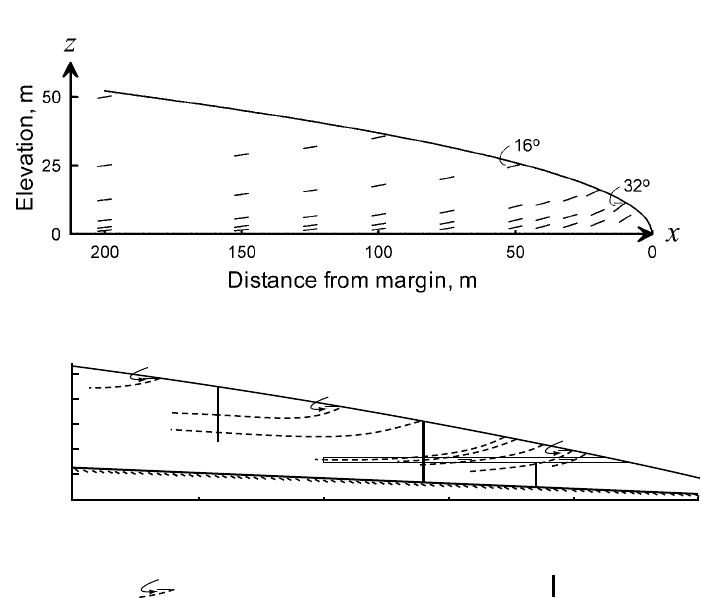
Components of foliation 357
(a)
50
m
0
100200300
Boreholes
Distance from margin, m
Ice tunnel
38
o
15
o
6
o
0
o
27
o
21
o
27
o
Trace and measured dip of foliation
(b)
Figure 13.7. (a) Foliation attitudes in the margin of an idealized perfectly
plastic glacier with a parabolic surface profile. See text for explanation. (b) Cross
section of the margin of Barnes Ice Cap showing dips of foliation planes
measured on the ice surface and in a tunnel excavated in the margin. Dashed
lines show traces of foliation planes inferred from measured dips and core
stratigraphy.
surface. This is rarely the case. Elongate bubbles and, in some instances,
elongate crystals may contribute to the banded appearance.
Foliation is the end product of subjecting inhomogeneities of any
origin to cumulative stretching and shearing by strains such as those
discussed in the first part of this chapter. After such treatment, the origin
of the initial inhomogeneity is not likely to be obvious. Suppose, for
example, that the 1 m cube we mentioned earlier were a Michelangelo
sculpture in a material with a rheology similar to that of ice. Would we
recognize it after it had become a ribbon 135 m long and 7.5 mm thick?
Perhaps we could identify the material, but certainly not the original
handsome shape.
358 Finite strain and the origin of foliation
So what are the inhomogeneities that result in foliation? The most
obvious is the sedimentary stratification that one sees in crevasse walls
in the accumulation area. This stratification is defined by variations in
grain size, particularly near the base of an annual layer where depth
hoar forms. Wind-blown dust picked up from snow-free ground dur-
ing the melt season commonly discolors the surface of annual layers,
and percolating meltwater may spread out and refreeze along horizons
defined by variations in snow density, forming relatively bubble-free
lenses. Both contribute to the stratified appearance. Gland-shaped bod-
ies of ice may also form from refreezing of percolating meltwater (p. 20).
From the pattern of elongation directions shown in Figure 13.5b,itis
clear that these inhomogeneities will be stretched longitudinally and
compressed vertically. Thus, the deformation accentuates the original
layering. By the time the inhomogeneities reappear low in the abla-
tion area, they will bear little resemblance to the original sedimentary
stratification or glandular structures. Once such inhomogeneities have
been deformed beyond ready recognition, the structure is properly called
foliation.
Another major component of foliation is crevasse fillings. Snow
blows into crevasses during the winter and meltwater may saturate this
snow during the summer. When the crevasse gets moved into a location,
or rotated into an orientation, such that stresses across it are compres-
sional, it closes and this filling gets squashed. A band is thus formed that
cross cuts either sedimentary layering or foliation derived from such lay-
ering. Initially, this cross-cutting relation is obvious and the filling can be
properly identified as what it is, even if it cross cuts foliation the origin of
which cannot be identified. However, once the filling has been squashed
further, rotated to near parallelism with other foliation, and stretched, its
origin will be less obvious. Careful observers, however, may still be able
to detect the cross-cutting relation.
Another prominent component of foliation in basal ice is debris. As
we have discussed, there are various mechanisms by which debris may
become entrained in basal ice – the refreezing part of the regelation
cycle, freeze-on by the mechanisms discussed by Robin (Figure 7.6)or
in areas where temperature gradients in basal ice lead to local refreezing
(Figure 6.12), entrainment in frazil ice in overdeepenings (Figure 8.33),
and so forth. In all situations, the resulting layers are parallel to the bed
or valley walls and are in areas subject to high rates of simple shear. The
precise origin of the layers is hard to determine before they become
deformed, and after shearing the task is usually hopeless, although
chemical and isotopic signatures may help (Souchez and Lorrain,
1978).

Components of foliation 359
Foliation in the marginal zone
We noted above that foliation in glacier margins has often been mistaken
for so called “shear planes” that would presumably be parallel to planes
of maximum shear stress. Here, we demonstrate that the upglacier dip
of the foliation at a glacier surface bears little relation to directions of
maximum shear stress.
As in the case of Figures 13.5 and 13.6, the first task is to determine
the velocity field. Then we use that velocity field to see how foliation
that is nearly parallel to the bed some distance from the margin will be
deformed as it is passively advected to the margin.
We adopt a coordinate system in which the origin is at the margin,
the x-axis is horizontal and directed upglacier along the bed, and the
z-axis is vertical and positive upward (Figure 13.7a). We assume that:
(1) the profile of the ice surface in the marginal zone can be approximated
by h =
√
cx,where h is the surface elevation, x is the distance from the
margin and c is a constant
1
; (2) the ablation rate, b
n
(a negative number),
is uniform over the area of interest; (3) the profile is a steady-state profile
with b
n
=−w
s
+ u
s
tan α (Equation (5.26)); (4) the horizontal velocity,
u,isindependent of depth; (5) the strain is two dimensional (plane
strain); and (6) ice is incompressible. The amount of ice lost by ablation
downglacier from a position x is then b
n
x and this must equal the mass
flux past x,or
uh. Thus,
u =
b
n
x
√
cx
= x
1/2
(13.7)
where =b
n
c
1/2
. (As b
n
is negative, is negative. This is consistent with
u being in the negative x-direction.) The assumption of incompressibility
may be represented by:
∂u
∂x
+
∂w
∂z
= 0 (13.8)
Differentiating Equation (13.7) and using the result to integrate Equation
(13.8) yields:
w =−
1
2
x
−1/2
z (13.9)
We now determine the coordinates of an element of ice as a func-
tion of time. The element starts at position (x
o
, z
o
)attime t = 0. As
u = dx/dt, Equation (13.7) can be integrated to obtain:
x =
x
1/2
o
+
1
2
t
2
(13.10)
1
This equation, first derived by Nye (1951), can be obtained by integrating Equation (5.2c)
with α = dh/dx. The reader will then find that c =
√
2σ
zx
/ρg.

360 Finite strain and the origin of foliation
Then combining Equations (13.9) and (13.10)toeliminate x, noting that
w = dz/dt, and integrating we obtain:
z = z
o
x
o
x
1/2
(13.11)
where z is the height of the element of ice after it has traveled a distance
(x
o
– x) from (x
o
, z
o
). The position of the element at time t
1
can be
determined by selecting a time t
1
> 0 and solving Equation (13.10) for
x and then Equation (13.11) for z.Aplot of x versus z defines the path
of the element. By setting z =
√
cx in Equation (13.11) and solving
for x we can determine the x-coordinate of the point where the element
reaches the glacier surface.
Now consider a foliation plane in this element of ice. At (x
o
, z
o
) the
plane has an upglacier dip, β
o
, with respect to the particle path, and we
wish to compute its dip when the element reaches the glacier surface.
(Because θ
c
is always greater than 0 under steady-state conditions, the
foliation plane will dip more steeply than the particle path. The conse-
quences of a non-steady-state situation will be discussed further below.)
The element is subjected to longitudinal compression and vertical exten-
sion which will change the inclination of any line that is not parallel to
the direction of compression or extension (Figure 12.12). In addition,
at any given height above the bed, w increases toward the margin as h
decreases (Equation (13.9), noting that x
1/2
= b
n
/h). Therefore, the
shear strain ∂w/∂x will also increase the upglacier inclination of the
plane. The problem thus strongly resembles the deformation of a bore-
hole (Chapter 12)except that now the “hole” is nearly horizontal, not
vertical, and the primary shear to which it is subjected is ∂w/∂x, not
∂u/∂z. Consequently, Equation (12.49)isapplicable in the form:
∂β
∂t
=
∂w
∂x
+ 2β
∂w
∂z
− u
∂β
∂x
(13.12)
To express β in terms of x alone, we obtain ∂w/∂x and ∂w/∂z from
Equation (13.9) and use the chain rule:
dβ
dt
=
dβ
dx
dx
dt
to evaluate the term on the left. Noting that dx/dt=u and using Equation
(13.11), we end up with a first-order linear ordinary differential equation:
dβ
dx
+
β
2x
−
z
o
x
1/2
o
8x
5/2
= 0 (13.13)
which can be solved by setting β =a(x)b(x), where a and b are functions
of x to be determined (Sokolnikoff and Redheffer, 1958, pp. 23–24). The
result is:
β =
x
o
x
β
o
+
z
o
8
1
x
o
−
1
x
(13.14)
